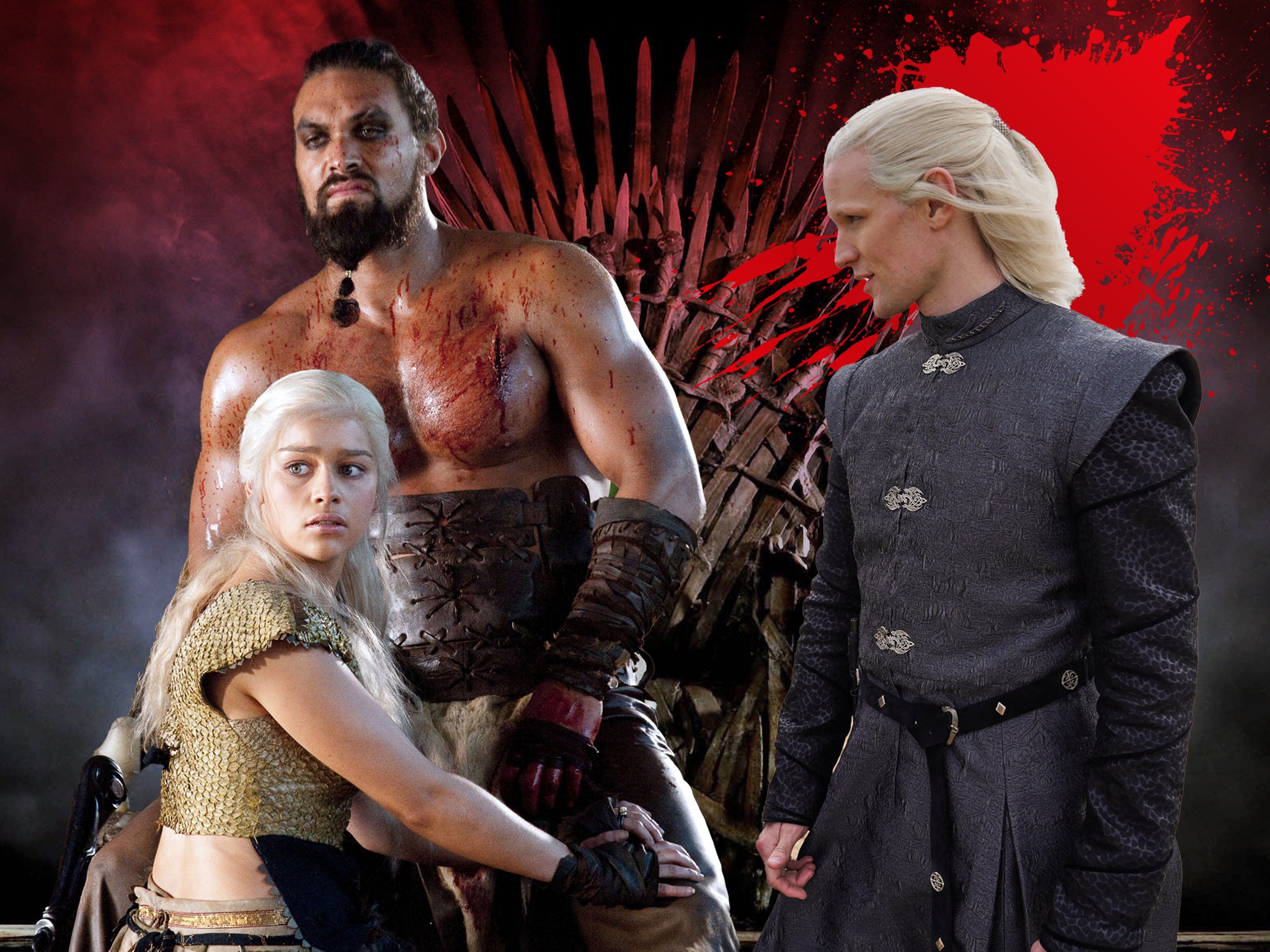Game of Thrones was built on blood and boobs – House of the Dragon can’t escape that
The original HBO epic was condemned for its depiction of sex and violence. And while the prequel talks the talk about being more progressive than its predecessor, writes Nick Hilton, does it walk the walk?


Your support helps us to tell the story
From reproductive rights to climate change to Big Tech, The Independent is on the ground when the story is developing. Whether it's investigating the financials of Elon Musk's pro-Trump PAC or producing our latest documentary, 'The A Word', which shines a light on the American women fighting for reproductive rights, we know how important it is to parse out the facts from the messaging.
At such a critical moment in US history, we need reporters on the ground. Your donation allows us to keep sending journalists to speak to both sides of the story.
The Independent is trusted by Americans across the entire political spectrum. And unlike many other quality news outlets, we choose not to lock Americans out of our reporting and analysis with paywalls. We believe quality journalism should be available to everyone, paid for by those who can afford it.
Your support makes all the difference.Moralising about TV shows is an art almost as ancient as the medium itself. Think back – if you’re in your seventies or older – to the controversies around showing Lucille Ball’s pregnancy on I Love Lucy, a move that resulted in CBS insisting that the character could only be referred to as “expecting”. Indeed, censoriousness has stalked television so relentlessly that the original series of HBO’s Gossip Girl, in reality a fairly tame depiction of teenage sex lives, harnessed the outrage as part of their advertising campaign. “Every parent’s nightmare” and “a nasty piece of work”, the show’s posters proclaimed. But perhaps no show has generated such a whirlwind of hand-wringing as HBO’s Game of Thrones.
It is a series, set in a fantasy world where technology and politics roughly resemble the Middle Ages, brimming with sex and violence. So naturally, a cottage industry of comment pieces sprung up to condemn the show throughout its eight-year run. “Thrones’ treatment of women has irreparably tainted the series,” one announced. Another concluded that “a series which subjected its female characters to endless sexual violence was on their attackers’ side”, while, damningly, another asked, “How much misogyny and racism are we expected to put up with in the name of entertainment?”
It was a show that always toed the line in depicting a vicious world, quite separate from our own. In order to add dramatic weight to the rise of the show’s trio of heroines – Daenerys, Sansa, and Arya – in a society that would not let them be protagonists, they were often subjected to unedifying levels of trauma. Extreme sexual violence, particularly, became something of a trope in the show, tarnishing, for many people, the simple pleasure of watching a swords-and-sandals romp. And yet still, while accusations of sexism, racism and brutality were filling column inches, they weren’t putting off viewers.
In the years of the show’s run (2011-2019) the search term “Game of Thrones” regularly appeared in the 10 most Googled phrases of the year. And the absolute thotfest of actors also appeared irresistible to viewers, with Emilia Clarke and Kit Harington subjected to the thirstiest scrutiny. The old marketing cliche that “sex sells” proved true, and the show leaned into the tired belief that modern audiences are desensitised to violence. A bit of boning, a bit of beheading. It was a winning formula.
But, this month, audiences are returning to Westeros in a different climate, for the long-awaited prequel, House of the Dragon. Sex had been on the decline in the Seven Kingdoms (can we blame millennials for that?), with – if slightly strange men on the internet are to be believed – the nakedness of the show dwindling from 33 nude people in the Game of Thrones’ opening season (88 per cent of whom were women) to just six people in the buff by the final series (half of whom were men). Sure, the characters were mostly engaged in staving off the existential threat of the Night King, but it’s possible to read this as a live response to some of the show’s critics.
And the new series, House of the Dragon, is talking the talk about being a more modern production (even though it is set a couple of hundred years before Game of Thrones). Speaking to The Independent about his leading role as Viserys I, Paddy Considine said he was trying to bring a more tactile, almost feminine, quality to the king. “When he meets his grandchildren,” the Burton-born actor said, “he picks them up, and kisses them, and holds them… I just used my mum as the template.” In another interview, Considine picks up the thread of how his own childhood fed into his depiction of the troubled Targaryen clan. “My brother and sisters find it hard to speak to each other because of the household that we were brought up in,” he said. “It left scars on us and that’s a tragedy. We can’t be close with each other because we can’t communicate.”
But the actor who has most neatly summed up the cognitive dissonance of House of the Dragon’s publicity tour is Matt Smith, who plays black sheep Daemon Targaryen (responsible for much of the show’s shagging and shanking). “You do find yourself asking, ‘Do we need another sex scene?’” he observed in a recent interview. “And they’re like, ‘Yeah, we do.’” When pressed on whether his character would be seen getting his leg over, Smith replied, “Yeah – slightly too much, if you ask me.”

He’s not lying. In just the first episode of House of the Dragon, Daemon’s modesty is protected by only the thinnest of robes – a luxury not afforded to the extras, male and female, with one scene showing as close to penetrative sex as I can remember on TV. And if you’re agonised by the variation of male and female nudity, while I can’t offer percentage breakdowns, I will say that the breasts and bums are presented in the act, so to speak, while the only penis we see onscreen has been recently severed from its owner’s body.
But the new series will, undoubtedly, take a different stance on the thorniest issue: the depiction of sexual violence. “I’d like to clarify that we do not depict sexual violence in the show,” executive producer Sara Hess said after an interview in which she confirmed that House of the Dragon would, once again, feature a rape storyline “We handle one instance off-screen, and instead show the aftermath and impact on the victim and the mother of the perpetrator.” The challenge has always been to draw a clear line between the sex and violence used for pure titillation or entertainment, and the sexual violence depicted as part of the show’s narrative complexity. It’s a line that Game of Thrones, on multiple occasions, failed to draw.
The creators of House of the Dragon saw that backlash. They know how to have an easy life, in terms of avoiding column inches dedicated to condemning them. But they also know that the success of Game of Thrones was built on blood and boobs, bludgeonings and beddings. And House of the Dragon, for all that its actors might have license to talk about its softer edges, is the same show. People will be burned to a crisp by winged beasts and eaten alive by crabs. There will be illicit affairs and orgies and incest. This might not be Game of Thrones but it is the world of Game of Thrones, and for all talk of creating something more progressive, the show understands that audiences love the moral wilderness of Westeros at its most regressive.
House of the Dragon will premiere at 2am on Monday 22 August on Sky. The episode will then be repeated at 9pm on Monday, and will be available to stream on Sky and NOW after its initial airing




Join our commenting forum
Join thought-provoking conversations, follow other Independent readers and see their replies
Comments